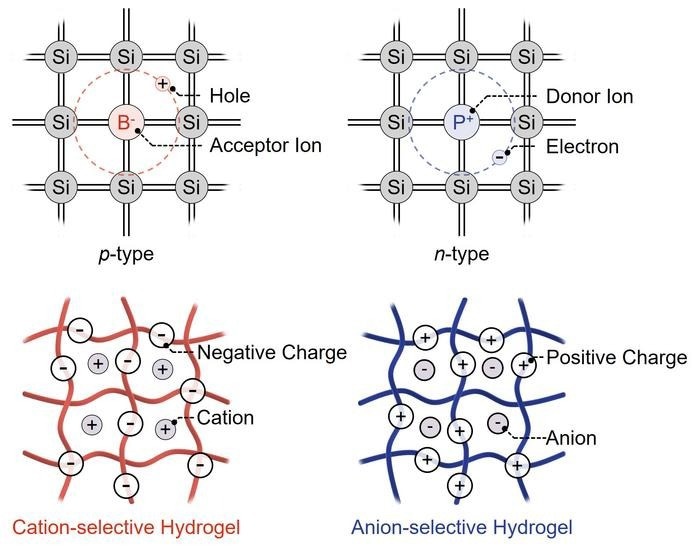Researchers from the University of Oxford have taken a big step toward the realization of a type of “biological electricity” that may be applied to several biomedical and bioengineering applications, such as communicating with living human cells. The study was published in the journal Science.
 Cation- and anion-selective hydrogels are the ionic equivalents of p- and n-type electronic semiconductors. Image Credit: Yujia Zhang
Cation- and anion-selective hydrogels are the ionic equivalents of p- and n-type electronic semiconductors. Image Credit: Yujia Zhang
One of the most fascinating and quickly expanding fields of biological engineering is iontronic devices. These use ions (charged particles), such as sodium, potassium, and calcium ions, to transport information like the human brain rather than electricity. In the end, biocompatible, energy-efficient, and extremely accurate signaling systems, including those for medication administration, may be made possible by iontronic devices.
Iontronic devices are usually positioned inside solid scaffolds, making it difficult to integrate with soft tissues. In their new study, researchers from the University of Oxford have successfully created tiny, multipurpose iontronic devices using biocompatible hydrogel droplets.
The hydrogels act as ionic counterparts to electronic semiconductors, allowing for the control of ion movement like the regulation of electron flow in electronic devices. The microscale droplets are assembled using surfactants (soap-like molecules) and are designed to conduct ions after being activated by light, which causes them to link together—a technique developed by the research team.
A combination of droplet and iontronics, the researchers have dubbed this group of gadgets dropletronics. The researchers developed dropletronic diodes, transistors, logic gates, and memory devices by combining microscale nanoliter hydrogel droplets.
The efficiency and response time of the dropletronic devices are higher than those of any soft iontronic devices created to date. With the added benefit of not being encased in a hard matrix, they are even on par with solid iontronic devices.
Dr. Yujia Zhang, Study Lead Researcher at the Department of Chemistry, University of Oxford, stated: "Ions have many advantages over electrons: for instance, the fact they have various sizes and charges means they could be used to achieve various functions in parallel. Through the incorporation of large ionic polymers, we demonstrated a dropletronic device with long-term memory storage, which has not been achieved with previous iontronic approaches and offers an unconventional pathway to neuromorphic applications."
Dropletronic devices can regulate ion movements, interface with cells, and record biological signals, as both operate using the same “ionic language.”
In this study, the research team developed biocompatible sensors using the devices to record electrical signals from beating human heart cells.
This is the first example of a lab-built biological sensor that can sense and respond to changes in function of human heart cells in a dish. This finding is an exciting step towards the fabrication of more complex biological devices that will sense a variety of abnormalities in an organ and react by delivering drugs intelligently inside the body.
Dr. Christopher Toepfer, Associate Professor, Radcliffe Department of Medicine, University of Oxford
The researchers' integration of dropletronics with living matter would make a biocompatible method of direct ionic communication possible, including the potential to identify several essential ionic and molecular species.
This would create new opportunities in several fields, most notably clinical medicine. For neuromorphic information processing and computations, dropletronic circuits might also offer a way to create ionic logic systems that resemble neurons.
Dr Zhang has used a creative, highly multidisciplinary approach including aspects of electrochemistry, polymer chemistry, surface physics, and device engineering to produce the first microscale “dropletronic” devices. The functional capabilities of these structures demonstrate that they might soon be elaborated into practicable devices with applications in both fundamental science and medicine.
Hagan Bayley, Professor and Study Leader, Department of Chemistry, University of Oxford
Journal Reference:
Zhang, Y., et al. (2024) Microscale droplet assembly enables biocompatible multifunctional modular iontronics. Science. doi.org/10.1126/science.adr0428.